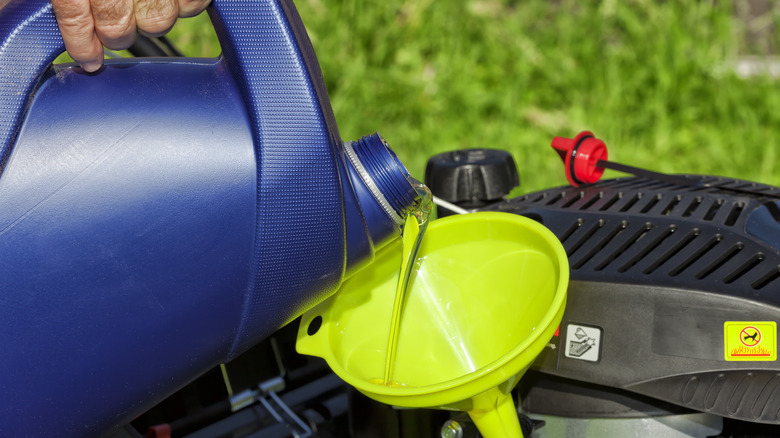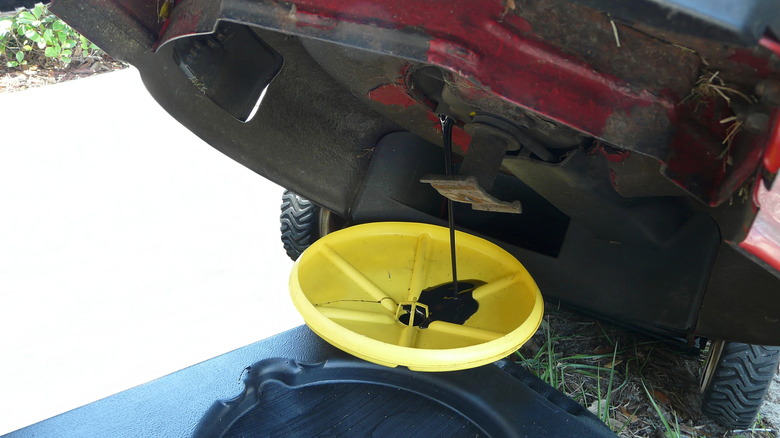How To Pick The Right Oil For Your Lawn Mower
You probably know the importance of changing the oil in your lawn mower, which helps the motor to run efficiently and lengthens its lifespan. Not only is it important to take on this task regularly, but you also need to use the right motor oil. Now, if you weren't aware that different types of motor oil are available, you need to start by understanding the differences. The type of engine you have, as well as the level of performance you want to receive and the type of climate in which you live, all play a role in determining what you should select. You can pick among various viscosities, seasonal blends, weights, and the materials used to create the specific formulas.
Before digging into the various options you have, you need to have a bit of information in hand to make the proper selection. Look on the lawn mower motor for a sticker that indicates which type of motor oil you should use with it. Your printed user manual also should list this information. Absent these items, knowing your brand and model of lawn mower is helpful. You may need to know the model of the motor, too. You then can search the internet for a copy of the user manual, which should specify the type of motor oil to use. Just be careful, as some websites that claim to have user manuals are actually sites that contain malware. Seek out the user manual at the manufacturer's website directly.
Deciphering the numbers and letters used to label types of motor oil
When you pick up a bottle of motor oil, it will have a series of numbers and letters printed on it in a prominent place, which is the grading system. It's important to understand this system so you can select the right product. You'll frequently see SAE on the label — it refers to the Society of Automotive Engineers, which created the grading system in use with the various types of motor oils.
The first number refers to the viscosity rating, or thickness, of the motor oil when the motor is cold. (The "W" in the number stands for winter.) The first number can range from 0W to 25W. Lower numbers in the grading system specify a thinner viscosity. Commonly, mowers make use of 10W if they even need a cold temperature rating. (Not all products will list a W rating.) The second number refers to the viscosity at the normal operating temperature of the mower, which is around the boiling point of water. The second number can range between 20 and 60, with 30 being the most common setting used with motor oil for a lawn mower.
One of the most common motor oil options is SAE 30. It works best in warm weather, which is when most people are mowing. Making use of a 10W-30 product helps the mower start better in cold weather. Commercial mowing companies may use high-performance 15W-50 products in their mower engines.
Selecting the best formula to use when changing your lawn mower's motor oil
You can select among three different formulas when purchasing motor oil: Conventional, synthetic blend, and full synthetic. Your lawn mower's manufacturer may have a specific formula it wants you to use, as specified in the user manual. If not, you can select the option that best meets your needs.
Conventional formulas are the least expensive and are the most commonly available for purchase. Older mower engines probably need conventional formulas, which consist of mineral-based products refined from crude oil. Full synthetic uses a base of synthetic oil that has several additives designed to increase the performance of the product. The additives can be quite different from brand to brand. A synthetic blend is a mixture of synthetic and conventional. This allows it to have a slightly better performance than conventional, including having a high oxidation resistance.
It's also important to mention that regardless of which product you decide to use, you must dispose of the used motor oil in the right way after changing it. Motor oil does not wear out. Rather, it just becomes dirty as it goes through the motor of a lawn mower, car, or other device. By recycling it properly, it can be used again, and it doesn't end up causing pollution in water supplies or soil. Check with local recycling centers, local landfills, and local governments to find the right place to take your used oil.


